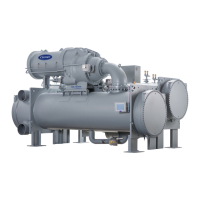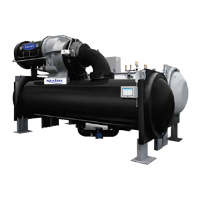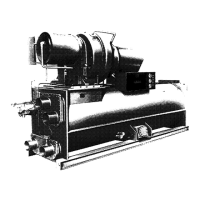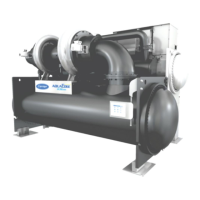43
Table 7 — Capacity Overrides Table
Remote Start/Stop Controls — A remote device, such
as a timeclock that uses a set of contacts, may be used to start
and stop the chiller. However, the device should not be pro-
grammed to start and stop the chiller in excess of 2 or 3 times
every 12 hours. If more than 8 starts in 12 hours (the STARTS
IN 12 HOURS parameter on the MAINSTAT screen) occur,
(not counting either recycle restarts or auto. restarts after power
failure) an excessive starts alarm displays, preventing the
chiller from starting. The operator must press the
softkey on the ICVC to override the starts counter and start the
chiller. If the chiller records 12 starts (excluding recycle starts)
in a sliding 12-hour period, it can be restarted only by pressing
the softkey followed by the or soft-
key. This ensures that, if the automatic system is malfunction-
ing, the chiller will not repeatedly cycle on and off. If the
AUTO RESTART OPTION in the OPTIONS screen and the
REMOTE CONTACTS OPTION are enabled, the REMOTE
CONTACTS must be closed in order for the chiller to restart
following a power failure. If the automatic restart after a power
failure option (AUTO RESTART OPTION on the OPTIONS
screen) is not activated when a power failure occurs, and if the
remote contact is closed, the chiller will indicate an alarm
because of the loss of voltage.
The contacts for remote start are wired into terminals 23 and
24 of the low voltage terminal strip in the VFD enclosure. See
the certified drawings for further details on contact ratings. The
contacts must have 24 vac dry contact rating.
Spare Safety and Spare Temperature Inputs —
Normally closed (NC) discrete inputs for additional field-
supplied safeties may be wired to the spare protective limits
input channel in place of the factory-installed jumper on
terminals 19 and 20 of the low voltage terminal strip. The
opening of any contact will result in a safety shutdown and a
display on the ICVC. Refer to the certified drawings for safety
contact ratings.
Extra analog temperature sensors may also be added to the
CCM module (SPARE TEMPERATURE #1 and SPARE
TEMPERATURE #2) at terminals J4 25-26 and J4 27-28,
respectively. The analog temperature sensors may be config-
ured in the EQUIPMENT SERVICE/SETUP1 table to cause
an alert (Enable value 1 or 2) or alarm (Enable value 3 or 4),
or neither (Enable value 0). An alarm will shut down a running
chiller, but an alert will not. The fault condition will be
triggered when crossing a high limit (Enable value 2 or 4) or
low limit (Enable value 1 or 3), configurable between –40 F to
245 F (–40 C to 118 C). The spare temperature sensors are
readable on the CCN network. They also have specific uses
as common temperature sensors in a Lead/Lag system. See
page 47.
Alarm (Trip) Output Contacts — One set of alarm
contacts is provided in the VFD. The contact ratings are
provided in the certified drawings. The contacts are located on
terminals 9 and 10 of the TB2 field wiring terminal strip in the
VFD enclosure.
OVERRIDE
CONDITION
FIRST STAGE SET POINT SECOND STAGE SET POINT OVERRIDE TERMINATION
View/Modify on
ICVC Screen
Override Default
Value
Configurable
Range
Value Value
High Condenser Pressure
(COND PRESS OVERRIDE)
SETUP1
CONDENSER
PRESSURE
>125 psig (862 kPa)
90 to 165 psig
(621 to 1138 kPa)
CONDENSER PRESSURE
> COND PRESS OVERRIDE
+ 2.4 psig (16.5 kPA)
CONDENSER PRESSURE
< CONDENSER PRESS
OVERRIDE – 1 PSI (6.9 kPa)
High Motor Temperature
(COMP MOTOR TEMP
OVERRIDE)
SETUP1
COMP MOTOR
WINDING TEMP
> 200 F (93 C)
150 to 200 F
(66 to 93 C)
COMP MOTOR WINDING TEMP
> COMP MOTOR TEMP OVER-
RIDE + 10 F (5.6 C)
COMPR MOTOR WINDING
TEMP < COMP MOTOR TEMP
OVERRIDE – 2 F (1.1 C)
Low Evaporator Temperature
(REFRIG OVERRIDE
DELTA T)
SETUP1
EVAPORATOR
REFRIG TEMP
< EVAP REFRIG
TRIPPOINT + 3 F
(1.7 C)
2 to 5 F
(1.1 to 2.8 C)
EVAPORATOR REFRIG TEMP
< EVAP REF OVERRIDE TEMP
- 1 F (.6 C)
NOTE: EVAP REF OVERRIDE
TEMP = EVAP REFRIG TRIP-
POINT + REFRIG OVERRIDE
DELTA T
EVAP REFRIG TEMP
> EVAP REF OVERRIDE TEMP
+ 2 F (1.1 C)
High Compressor Lift
(SURGE/HGBP DELTA T,P)
OPTIONS
Min T1: 1.5 F (0.8 C)
Min P1: 50 psid
(345 kPa)
Max T2: 10 F (5.6 C)
Max P2: 85 psid
(586 kPad)
0.5 - 2.0 F
(0.3 - 1.1 C)
30 - 170 psid
(207 - 1172 kPad)
0.5 - 20 F
(0.3 - 11.1 C)
50 - 170 psid
(345 - 1172 kPad)
None
ACTIVE DELTA T > SURGE/
HGBP DELTA T + SURGE/HGBP
DEADBAND
Manual Guide Vane Target
(TARGET GUIDE VANE POS)
COMPRESS Automatic 0 to 100% None
Press RELEASE softkey after
selecting TARGET GUIDE VANE
POS
Manual Speed Control
(TARGET VFD SPEED)
COMPRESS Automatic
VFD MINIMUM
SPEED to 100%
Forced TARGET VFD SPEED
cannot override either a
capacity inhibit or a capacity
decrease command generated by
the PIC III
Press RELEASE softkey after
selecting TARGET VFD SPEED
Motor Load
(ACTIVE DEMAND LIMIT)
MAINSTAT Automatic 40 to 100%
ACTIVE DEMAND LIMIT
> Set Point + 5%
ACTIVE DEMAND LIMIT
< Set Point – 2%
Low Discharge Superheat OVERRIDE
ACTUAL SUPER-
HEAT < SUPERHEAT
REQUIRED for
conditions
None
ACTUAL SUPERHEAT
< SUPERHEAT REQUIRED
– 1.25 F (0.7 C)
ACTUAL SUPERHEAT
> SUPERHEAT REQUIRED
+ 1 F (0.56 C)
High Rectifier Temperature
(RECTIFIER TEMP
OVERRIDE)
SETUP1
RECTIFIER
TEMPERATURE >
160 F (71 C)
155 to 170 F
(68 to 77 C)
RECTIFIER TEMP
> RECTIFIER TEMP OVERRIDE
+ 10 F (5.6 C)
RECTIFIER TEMP
< RECTIFIER TEMP OVERRIDE
– 5 F (2.8 C)
High Inverter Temperature
(INVERTER TEMP
OVERRIDE)
SETUP1
INVERTER
TEMPERATURE >
160 F (71 C)
155 to 170 F
(68 to 77 C)
INVERTER TEMP
> INVERTER TEMP OVERRIDE
+ 10 F (5.6 C)
INVERTER TEMP
< INVERTER TEMP OVERRIDE
– 5 F (2.8 C)
RESET
RESET LOCAL CCN

